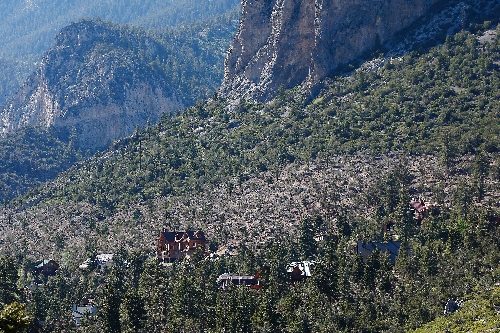Project helps douse wildfire danger in Spring Mountains
When flames engulfed part of Kyle Canyon less than a year ago, the fire was stopped just 50 feet from some homes in the Rainbow subdivision.
Many residents and firefighters credit the patches of thinned forest, known as fuel breaks, for a safe outcome of the 20-acre Cathedral Fire. Firefighters had created the breaks in that area as part of the Spring Mountains Hazardous Fuels Reduction effort, which was completed last fall.
"I live up there because of the beautiful trees, but if we have a fire and haven't thinned the forest, we could lose the whole mountain," said Deborah Martin, a volunteer firefighter whose home was 350 feet from the blaze.
The $7.7 million Hazardous Fuels Reduction project, funded by the Southern Nevada Public Land Management Act, covered more than 2,000 total acres throughout seven communities in the Spring Mountains. Prevention efforts focused on thinning the forest and cutting away low branches near about 1,000 homes and roads. The project is meant to increase firefighter safety and slow the spread of any blaze.
"It's safe to say that since the project, that extreme danger level has gone down," said Michael Frank, a fuel specialist and the prevention project manager with the U.S. Forest Service. "But there's always an inherent risk. There's still lots of the area that hasn't been treated."
Kyle Canyon is considered an extreme fire danger because the forest is dense and there is only one main road in and out of the area. Mount Charleston is also particularly dry, Frank said.
This is the first fire prevention effort that has focused on thinning the forest in the area, he said.
Near homes, trees now stand 10 feet apart rather than 10 inches, which gives firefighters more visibility and potential forest fires less fuel.
Frank said he first learned of such fuel breaks in 2002, when he responded to the Rodeo-Chediski Fire in east-central Arizona, which was the largest blaze in the state's history until Tuesday, when the Wallow Fire surpassed it in size.
On his second day at the Rodeo Fire, Frank passed a section where flames had already ravaged the town.
"The homes were just wiped out. It was a life-changing thing to see," Frank said.
"That scene -- all those homes burned -- made me think that there has to be something more we can do than squirting water on the line."
There, he learned to create fuel breaks with the crew as they rushed to thin the forest ahead of the fire's path, he said. It is a job that takes years, though, and should be done before a fire ever starts.
Such massive fires that destroy or threaten homes make the public more receptive to the controversial fire prevention projects that involve thinning the forest, Frank said.
Mount Charleston's Fire Safe Council works to educate residents about the hazards presented by a dense forest and how to protect their homes from wildfire, said Kim Otero, a council official.
The council and other volunteers picked up about 24 tons of pine needles to help in the prevention effort two weeks ago.
Frank said the council has helped to make future projects more welcome in the area. Proposals to thin more of the forest around Kyle Canyon are under way, but any work wouldn't be started for at least another three years, he said.
"I think the next one is going to be a lot more successful in terms of saving money and the community understanding that it's needed," Frank said.
Contact Jessica Fryman at jfryman@reviewjournal.com or 702-383-0264.



















